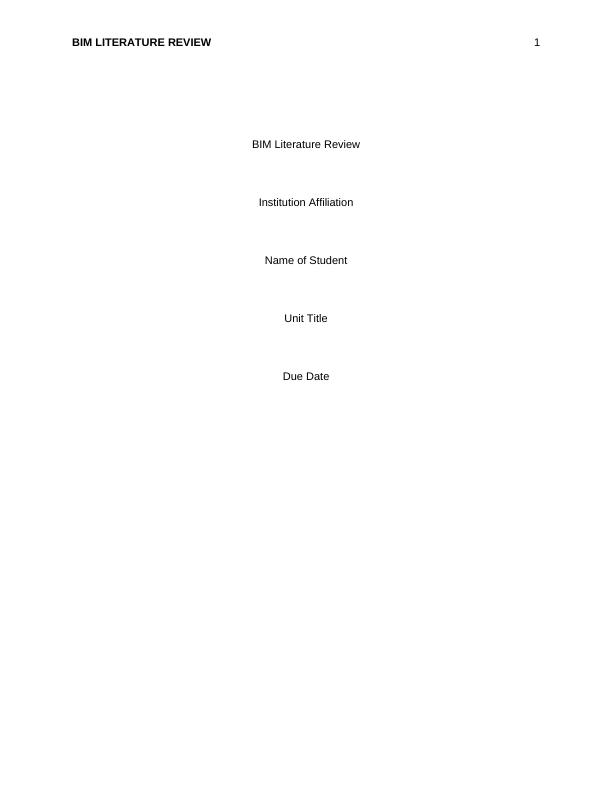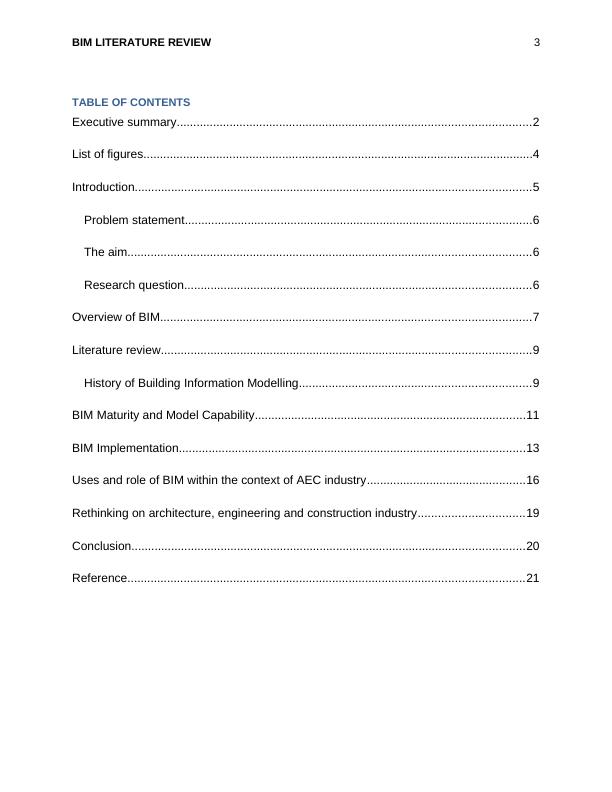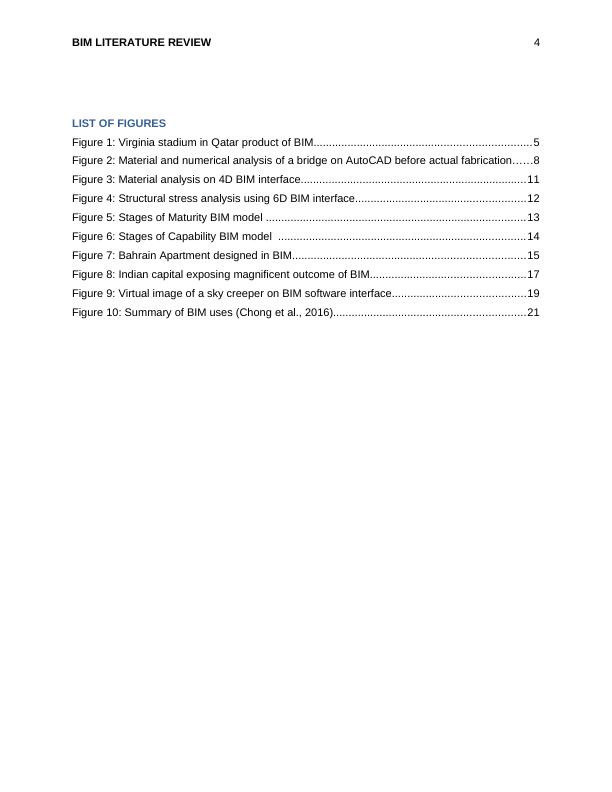The Application of Building Information Modeling Technology
REFERRAL WORK - Narrative literature review for the Building Information Modelling Management, Theory and Practice course in the Department of Mechanical and Construction Engineering at the Faculty of Engineering and Environment. Due date to be determined.
22 Pages5233 Words14 Views
Added on 2022-08-20
The Application of Building Information Modeling Technology
REFERRAL WORK - Narrative literature review for the Building Information Modelling Management, Theory and Practice course in the Department of Mechanical and Construction Engineering at the Faculty of Engineering and Environment. Due date to be determined.
Added on 2022-08-20
ShareRelated Documents
BIM LITERATURE REVIEW 1
BIM Literature Review
Institution Affiliation
Name of Student
Unit Title
Due Date
BIM Literature Review
Institution Affiliation
Name of Student
Unit Title
Due Date

BIM LITERATURE REVIEW 2
EXECUTIVE SUMMARY
The application of building information modeling technology in construction and asset
management has been of positive impact on the architecture, engineering, and construction
industry for over two decades now. This report has considered the review of BIM technology
since its introduction to the latest advancements. Developments in the application of BIM in the
AEC industry, it also examines the evolution of BIM technology from 2D modeling to 4D
modeling and projection of the future modeling interface that is anticipated to surface in the
recent future. Among the numerous merits of BIM are the perfect coordination and perfect
communication among stakeholders in the construction space. Other advantages being proper
planning and coordination of construction works, reduction in the overall project expenditure,
asset management
The foundation of this report was based on the research questioned that geared the study
process to the end such as to establish how BIM technology is perceived in AEC- industry,
evaluating key actors and stakeholders in BIM implementation together with their impacts on the
adoption of BIM in AEC industry to increase on productivity. This report also gives a clear
distinction between maturity and capability BIM models, with their importance in AEC
IINDUSTRY. And finally to establish the impact of applying BIM in construction and AEC
industries
EXECUTIVE SUMMARY
The application of building information modeling technology in construction and asset
management has been of positive impact on the architecture, engineering, and construction
industry for over two decades now. This report has considered the review of BIM technology
since its introduction to the latest advancements. Developments in the application of BIM in the
AEC industry, it also examines the evolution of BIM technology from 2D modeling to 4D
modeling and projection of the future modeling interface that is anticipated to surface in the
recent future. Among the numerous merits of BIM are the perfect coordination and perfect
communication among stakeholders in the construction space. Other advantages being proper
planning and coordination of construction works, reduction in the overall project expenditure,
asset management
The foundation of this report was based on the research questioned that geared the study
process to the end such as to establish how BIM technology is perceived in AEC- industry,
evaluating key actors and stakeholders in BIM implementation together with their impacts on the
adoption of BIM in AEC industry to increase on productivity. This report also gives a clear
distinction between maturity and capability BIM models, with their importance in AEC
IINDUSTRY. And finally to establish the impact of applying BIM in construction and AEC
industries

BIM LITERATURE REVIEW 3
TABLE OF CONTENTS
Executive summary...........................................................................................................2
List of figures......................................................................................................................4
Introduction........................................................................................................................5
Problem statement.........................................................................................................6
The aim..........................................................................................................................6
Research question.........................................................................................................6
Overview of BIM................................................................................................................7
Literature review................................................................................................................9
History of Building Information Modelling......................................................................9
BIM Maturity and Model Capability..................................................................................11
BIM Implementation.........................................................................................................13
Uses and role of BIM within the context of AEC industry................................................16
Rethinking on architecture, engineering and construction industry................................19
Conclusion.......................................................................................................................20
Reference........................................................................................................................21
TABLE OF CONTENTS
Executive summary...........................................................................................................2
List of figures......................................................................................................................4
Introduction........................................................................................................................5
Problem statement.........................................................................................................6
The aim..........................................................................................................................6
Research question.........................................................................................................6
Overview of BIM................................................................................................................7
Literature review................................................................................................................9
History of Building Information Modelling......................................................................9
BIM Maturity and Model Capability..................................................................................11
BIM Implementation.........................................................................................................13
Uses and role of BIM within the context of AEC industry................................................16
Rethinking on architecture, engineering and construction industry................................19
Conclusion.......................................................................................................................20
Reference........................................................................................................................21

BIM LITERATURE REVIEW 4
LIST OF FIGURES
Figure 1: Virginia stadium in Qatar product of BIM......................................................................5
Figure 2: Material and numerical analysis of a bridge on AutoCAD before actual fabrication......8
Figure 3: Material analysis on 4D BIM interface.........................................................................11
Figure 4: Structural stress analysis using 6D BIM interface.......................................................12
Figure 5: Stages of Maturity BIM model ....................................................................................13
Figure 6: Stages of Capability BIM model ................................................................................14
Figure 7: Bahrain Apartment designed in BIM...........................................................................15
Figure 8: Indian capital exposing magnificent outcome of BIM..................................................17
Figure 9: Virtual image of a sky creeper on BIM software interface...........................................19
Figure 10: Summary of BIM uses (Chong et al., 2016)..............................................................21
LIST OF FIGURES
Figure 1: Virginia stadium in Qatar product of BIM......................................................................5
Figure 2: Material and numerical analysis of a bridge on AutoCAD before actual fabrication......8
Figure 3: Material analysis on 4D BIM interface.........................................................................11
Figure 4: Structural stress analysis using 6D BIM interface.......................................................12
Figure 5: Stages of Maturity BIM model ....................................................................................13
Figure 6: Stages of Capability BIM model ................................................................................14
Figure 7: Bahrain Apartment designed in BIM...........................................................................15
Figure 8: Indian capital exposing magnificent outcome of BIM..................................................17
Figure 9: Virtual image of a sky creeper on BIM software interface...........................................19
Figure 10: Summary of BIM uses (Chong et al., 2016)..............................................................21

BIM LITERATURE REVIEW 5
INTRODUCTION
Building Information Modelling BIM was introduced in the architecture and construction industry
and has been in existence for almost two decades now. Twenty years ago, the building and
construction industry experienced challenges in project analysis and management; therefore,
the introduction of BIM was timely as it provided a solution to such difficulties. BIM has so far
enhanced project productivity acting as a tool of efficiency in the building and construction
industry (Yalcinkaya and Singh, 2014). Over the past 15 or so years of BIM existence, there has
been several research and studies undertaken to establish the functionality of BIM, with every
researcher giving definition, description, and impact of BIM based on personal opinions and
country of residence or area region of study (McAuley et al. 2017). This report tends to revisit
and provide a review on the concept of building information modeling technique as a framework
of structural assessment and building asset management.
Figure 1: Virginia stadium in Qatar product of BIM (Andriamamnjy., 2019)
AEC industries have been committed to having sustainable constructions through the
implementation of various techniques and methods in their construction works. However, over
the past, there has been a challenge in material optimization as most constructions consume a
large volume of construction materials that, in turn, lead to the production of more materials as
waste. The process of waste removal in construction buildings uses a lot of energy and other
processes such as heating and cooling. In Qatar, buildings consume about 70% of the total
INTRODUCTION
Building Information Modelling BIM was introduced in the architecture and construction industry
and has been in existence for almost two decades now. Twenty years ago, the building and
construction industry experienced challenges in project analysis and management; therefore,
the introduction of BIM was timely as it provided a solution to such difficulties. BIM has so far
enhanced project productivity acting as a tool of efficiency in the building and construction
industry (Yalcinkaya and Singh, 2014). Over the past 15 or so years of BIM existence, there has
been several research and studies undertaken to establish the functionality of BIM, with every
researcher giving definition, description, and impact of BIM based on personal opinions and
country of residence or area region of study (McAuley et al. 2017). This report tends to revisit
and provide a review on the concept of building information modeling technique as a framework
of structural assessment and building asset management.
Figure 1: Virginia stadium in Qatar product of BIM (Andriamamnjy., 2019)
AEC industries have been committed to having sustainable constructions through the
implementation of various techniques and methods in their construction works. However, over
the past, there has been a challenge in material optimization as most constructions consume a
large volume of construction materials that, in turn, lead to the production of more materials as
waste. The process of waste removal in construction buildings uses a lot of energy and other
processes such as heating and cooling. In Qatar, buildings consume about 70% of the total

BIM LITERATURE REVIEW 6
electricity from the leading national grid. Buildings consume approximately 44% of raw
materials, produce 36% carbon dioxide, and 13% of potable water (Costin et al. 2018).
Therefore efforts and research had been made to establish the most effective and efficient way
of optimizing the building performance index.
Problem statement
For the longest time, AEC industry has had a low increase of productivity as compare to other
related industries. As a means of addressing the low increase in AEC productivity, many
research and studies has been considered by various scholars by introducing BIM technology in
the AEC- industry. However, despite BIM technology being implemented in AEC industry over
the past years, the industry’s productivity has not improved to substantive level. Currently there
are a quite a number of researchers, working on the theories to support reasons why the
productivity is still low and focusing on the limiting factors to full implementation of BIM in
construction industry.
The aim
The main purpose of this study is to analyze the underlying obstacle that hinders the adoption
and implementation of BIM in AEC-industry. The aim is to develop an understating of the
decision making process on BIM implementation in construction process. All these will leads to
better understanding on why there has been low increase in AEC- industry
Research question
In order to meet the aims and objectives of this research, the following research questions
informed the scope of the research:
The question of how decision on BIM is regarded in various construction projects, this aims at
establishing how contractors initialize BIM in their construction projects
How crucial information and decisions on BIM are arrived at, what merits and barriers has been
faced in implementation of BIM
Who are the key actors in the AEC industry that are responsible for BIM implementation, how
consensus decision relating to BIM are made and how BIM implementation has impacted the
AEC- industry.
electricity from the leading national grid. Buildings consume approximately 44% of raw
materials, produce 36% carbon dioxide, and 13% of potable water (Costin et al. 2018).
Therefore efforts and research had been made to establish the most effective and efficient way
of optimizing the building performance index.
Problem statement
For the longest time, AEC industry has had a low increase of productivity as compare to other
related industries. As a means of addressing the low increase in AEC productivity, many
research and studies has been considered by various scholars by introducing BIM technology in
the AEC- industry. However, despite BIM technology being implemented in AEC industry over
the past years, the industry’s productivity has not improved to substantive level. Currently there
are a quite a number of researchers, working on the theories to support reasons why the
productivity is still low and focusing on the limiting factors to full implementation of BIM in
construction industry.
The aim
The main purpose of this study is to analyze the underlying obstacle that hinders the adoption
and implementation of BIM in AEC-industry. The aim is to develop an understating of the
decision making process on BIM implementation in construction process. All these will leads to
better understanding on why there has been low increase in AEC- industry
Research question
In order to meet the aims and objectives of this research, the following research questions
informed the scope of the research:
The question of how decision on BIM is regarded in various construction projects, this aims at
establishing how contractors initialize BIM in their construction projects
How crucial information and decisions on BIM are arrived at, what merits and barriers has been
faced in implementation of BIM
Who are the key actors in the AEC industry that are responsible for BIM implementation, how
consensus decision relating to BIM are made and how BIM implementation has impacted the
AEC- industry.

End of preview
Want to access all the pages? Upload your documents or become a member.
Related Documents
KB7034: Building Information Modelling Managementlg...
|10
|2641
|405
CONS7825 - Advanced BIM in Constructionlg...
|11
|2732
|146
The Contribution of DYNAMO Visual Programming Software in the Evolution of BIMlg...
|50
|19073
|28
Extrinsic and intrinsic drivers of BIM adoption in the Australian AEC industry.lg...
|5
|928
|18
BIM Implementation in Balfour Beatty: Revolutionizing Construction Industrylg...
|13
|4050
|1
Benefits of Using BIM in Construction Projectslg...
|17
|7340
|121
